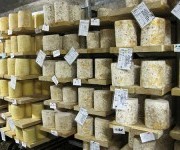How do the sensory qualities of cheese relate to the local landscape? Jasper Hill Farm and Cheese Cave.Photo: DJ Mitchell
Food Studies features the voices of 11 volunteer student bloggers from a variety of different food- and agriculture-related programs at universities around the world. You can explore the full series here.
What makes someone become a food scientist? Long ago, as a mathematics undergraduate who happened to love cooking and chemistry, I asked my advisor about food science as a possible graduate career. “You don’t want to do food science,” he said. “Not enough food, and not enough science.” To me, that sounded less like a warning than a challenge. I loved food, I loved science — perhaps I was exactly what food science was looking for?
In any case, five years later, here I am: a doctoral student in the Animal, Nutrition, and Food Sciences program at the University of Vermont. Before I took the plunge and pledged my soul to academia, I worked for several years in many of the stereotypical food jobs. I’ve been a farmhand, a line cook, an intern for Slow Food, and a cheesemonger; I’ve slung pizzas, coordinated fundraisers, and delivered CSA boxes. These days my professional interactions with food are on a completely academic basis, but I’m still an avid cook and a cocktail enthusiast.
I finished an MS in Food Science and Human Nutrition in 2010 at the University of Illinois, with a thesis on the flavor chemistry of American rye whiskey. Rye whiskey, of course, is the darling of classic cocktail enthusiasts, thought to be dramatically different from the currently more common bourbon whiskey. My research, however, demonstrates that the two American whiskeys have almost identical flavor chemical profiles, mostly based on the charred, new oak casks in which, by law, both must be aged.
Can sensory science be used to support small producers in Vermont? The Northeast Kingdom.Photo: DJ MitchellIn my PhD research, I’ve taken a detour from the chemical origins of flavor to explore a more holistic understanding of the human sensory perception of food. Sensory science is a sub-discipline of food science that seeks to objectively quantify what food tastes like. If you’ve ever heard of a “taste test” or, more relevantly, looked at one of those “flavor wheels” for wine or cheese or whiskey, you’ve brushed up against sensory science. I’m interested in finding out how sensory science, which in many ways was conceived as a tool to help industrial agriculture and food production, can be relevant to the emerging artisanal food sector.
This semester, I’ll be finishing my proposal for my dissertation research, which means that I have to outline what I intend to do with my funding for the next several years, and how that will lead to a few papers for the university and a shiny new degree for me. Here at Grist, I’ll be letting you in on the process, as I think through how to understand the sensory quality of Vermont cheeses, how food can be embedded in the working landscape and everyday experience, and what that means for local farmers and cheese makers.
I’ll also be drawing on what I’ve learned during my education as a food scientist to think about my undergraduate advisor’s dismissal of food science. Can food science address real food? Does it really serve science? And, perhaps most importantly, can I do some good, for myself and for the world, by trying to make sure both halves are addressed? In the battle lines that are often drawn between innovation and tradition in the food world, I like to think that there’s a third way, where academics can help us understand our food system and move it — incrementally, perhaps, but still unequivocally — in a positive direction.



